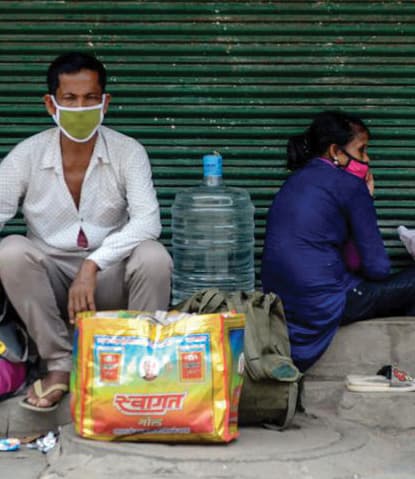“Solace of Migrants” is one of the three new invocations that Pope Francis added to the Litany of Loreto last June 2020. The other two are “Mother of Mercy” and Mother of Hope.” The Litany of Loreto is a compilation of titles by which Christians call upon the Mother of Jesus to invoke her help and comfort. These new additions respond to the realities of the time that we are living, explained Archbishop Arthur Roche, Secretary of the Congregation for Divine Worship and the Discipline of the Sacraments. Indeed, just as the COVID-19 pandemic is afflicting people across the globe today, so too have poverty, conflicts, and other difficulties which have forced many to leave their homes and motherlands. In their miserable state, those who know the Blessed Virgin turn to her for consolation. What then can be a more appropriate title for her than “Solace of Migrants”?

Jampacked in a motorboat attempting to cross the border by sea, or traveling without documents across a desert road, migrants have only one person they can call on in the silence of their aching hearts – the “Solace of Migrants.”
In their destination country, where development often depends on a workforce comprised largely of migrant workers, a spark of hope may light up in them. It does not matter what kind of job is available, or whether it is in inhospitable sectors such as service, construction, agriculture, or domestic work. They are ready to receive low wages, with little or no social protection. They can endure precarious, informal, unprotected, and even inhuman labor conditions, as long as they can start a new life, or support their families back home who count on their remittances. The appearance of the COVID-19 pandemic crisis has only aggravated the difficult situation of migrant workers everywhere. They are often discriminated against in the distribution of assistance provided by local authorities, thereby increasing threats to their human dignity.
Filipino migration then and now
The history of Filipino migration is definitely much longer, but it was in the 1970s that labor migration became a large-scale phenomenon. The economic conditions of the country then made it quite difficult to provide jobs and decent wages to its people. At the same time, oil-rich Gulf countries needed workers for their ambitious infrastructure projects. The push and pull factors came together!
At the outset, the Philippines intended its venture into organized international labor migration to be temporary, only until the time when the country would recover from its economic problems. However, the problems have not only remained but even multiplied. The demand for labor in the Gulf countries and in other regions in the globe increased. The scenario encouraged Filipinos to continue looking for a better future abroad. As a result, the flow of overseas Filipino workers (OFWs), who numbered a few thousands per year in the early 1970s, grew to a total of about 2.2 million workers today, according to official statistics.
Migrants have been hailed as heroes because their remittances have constituted some 35% of the financial flows to the Philippines. This is an important contribution to the coffers of a country that seems unable to trigger and sustain its own development.
To its credit, the Philippine government has invested in programs geared to take care of its migrant workers. The country is being considered an expert and a reference point for other developing countries in managing migration. At the same time, even independently of the government, Filipinos have developed the ability to respond, and to adjust, to the changing demands of the global labor market. Unexpectedly though, the COVID-19 pandemic uncovered vital flaws in the country’s strategy of managing migration. Filipinos who were quietly working abroad suddenly lost their jobs because of various quarantine impositions and even closed borders. Without social and employment protection, many lost their visas and their income, forcing them to come home… to a country almost totally unprepared to deal with a pandemic and much less with massive repatriation.

Last July 2020, the situation of thousands of locally stranded individuals (LSIs) crammed inside the Rizal Memorial Sports Complex became an example of the reception given to migrants who had lost their jobs abroad or in Metro Manila but could not go back to their home provinces. Provisions for temporary shelter were inadequate with no budget for food assistance. Because of the pandemic, they needed to undergo rapid testing for COVID-19 infection but ironically, the process was slow, taking more than two weeks to get the results. This kind of testing also proved to be unreliable, seeing that a surge in the number of cases occurred after some LSIs returned to their home provinces.
In the wake of all this, quite a few considerations could be made. Here are two of them.
First, where is the gratitude our country owes to these heroes? No, a red carpet was not necessary, but surely they would have appreciated better housing arrangements and food assistance. How sad and disappointing! Fortunately, there are Filipino citizens who are creative and have taken the initiative. The Pasay Chapter of a national organization started a collection to answer the SOS call sounded by some migrant workers stranded in one of the temporary shelters offered to them. Already, they had pooled together everything they could to buy food, but there was still no hope of being able to go back to their provinces. They were running out of resources. Probably the members of the Pasay group did not know them, but it was enough for them to realize that fellow human beings were in need of assistance for them to roll up their sleeves to help. They have become, as it were, the arms and hands of Mary comforting her migrant children.
Second, the Philippine program for international labor migration was intended to be temporary, but since the country has failed to develop economically in proportion to the demand for jobs, the exportation of labor is expected to remain. How seriously is the problem of development being tackled in the country? Why have huge amounts of remittances not been able to make development more visible?
A study, published in 2019 by Maruja Asis of the Scalabrini Migration Center, eyed agriculture as an alternative to international labor migration. A dynamic agriculture sector can offer many opportunities to young Filipinos and their participation in the sector would lower the high average age of Filipino farmers. Sadly, the agricultural sector is not attractive to those who are entering the labor market because it is considered hard work and an occupation that is not so glamorous. It is time to promote and nurture the interest in agriculture among our young people. They need to know that the sector does not include only farming or food production. They can also be trainers, entrepreneurs, researchers, scientists, policy-makers, bridges between farmers and investors, or between farmers and markets, etc. They must be introduced to training programs and innovative techniques in the sector, which can also contribute to their empowerment. Improving the Filipino youth’s access to land, financial services, green jobs, and markets will also allow their active participation in a wide range of agriculture-related activities.

Commitment to stop international labor migration needs to be taken seriously. To this end, should the Philippines not pour more resources into the agricultural sector to make it more attractive to the youth? During the lockdown, many families have resorted to backyard farming when breadwinners either lost their jobs or could not work and/or earn enough to make ends meet. Perhaps this pandemic has made us realize the value of the agricultural sector in our nation’s progress and development. May Mary, Solace of Migrants, be our model in giving people not only comfort, but also and more importantly, a dignified way of living.




